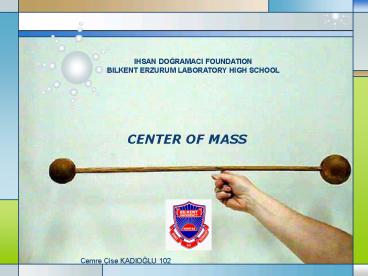CENTER OF MASS - PowerPoint PPT Presentation
1 / 15
Title:
CENTER OF MASS
Description:
IHSAN DO RAMACI FOUNDATION BILKENT ERZURUM LABORATORY HIGH SCHOOL CENTER OF MASS Cemre ise KADIO LU 102 KEY WORDS Balance Stability Resultant-gravitional forces ... – PowerPoint PPT presentation
Number of Views:1596
Avg rating:3.0/5.0
Title: CENTER OF MASS
1
CENTER OF MASS
IHSAN DOGRAMACI FOUNDATION BILKENT ERZURUM
LABORATORY HIGH SCHOOL
Cemre Çise KADIOGLU 102
2
KEY WORDS
Center of gravity, plumb line
Weight, torque
Resultant-gravitional forces
Stability
Balance
Equilibrium
Turning effect
3
What is centre of mass?
- The small forces act like a single force at G.
This means that they have the resultant force at
G. - The resultant force is the sticks weight.
- G is the centre of mass.
Gravitional forces on particles of stick
4
What is centre of mass?
- Centre of mass of a body is the body that moves
as though all of the mass were applied there.
5
Finding centre of mass
- If the object is uniform, for example a meter
stick, the center of mass will be at the exact
geometric center. - But, if the shape is irregular we use plumb line.
- Draw lines from each vertex along the plumb line
by assuming that the point is on that line - After drawing the lines the centre of the mass
will be on the intersection point of these lines.
G
Intersection point-Centre of mass
6
Finding the centre of mass
- But, if the shape is irregular we use plumb line.
- Draw lines from each vertex along the plumb line
by assuming that the point is on that line - After drawing the lines the centre of the mass
will be on the intersection point of these lines.
Intersection point-centre of mass
Plumb line
7
- Balancing unequal masses are again about centre
of mass - For example,
- The bus is heavier than the car so theyre not in
balance.
M2
M1
d2
d1
8
- In order to balance the system, we should change
their distances to the support. - Now theyre in balance.
d1
d2
9
Stability Equilibrium
- If an object isnt moving and remainig same, the
object is stable. - State of rest or balance due to the equal action
of opposing forces is called equilibrium. - When the object is stable its also in
equilibrium which means the forces acting on the
object and the forces turning effects are in
balance.
10
Stability-Equilibrium
Will turn to its original position
Small force will turn it over
Will definetely fall over before another force is
applied
11
Types of equilibrium
- There are three states of equilibrium,
12
Stable equilbrium
- The objects that have wide base also have the
lower centre of mass. - The lower the centre of mass is, the more stable
object is. - So its more difficult to fall over an object
with wider base.
13
Unstable equilibrium
- The objects that have very little base, have high
centre of mass. - And if these objects are tilted the centre of
mass immediately passes beyond the base. - So theyre not stable and its easy to fall these
objects over.
14
Neutral equilibrium
- The objects that are in neutral equilibrium stay
where theyre lefted. - When moved, it changes the position.
- Wherever they stay, their center of mass is
always over their base.
15
References
- Complete Physics for IGCSE
- http//dev.physicslab.org/Document.aspx?doctype3
filenameRotaryMotion_CenterMass.xml - http//dictionary.reference.com/browse/equilibrium
- http//en.wikipedia.org/wiki/Center_of_mass
- http//eteach.engr.wisc.edu/meibom/espp/slides/esp
p.ppt - http//solar.njit.edu/cdenker/physics111_lecture0
8.ppt































